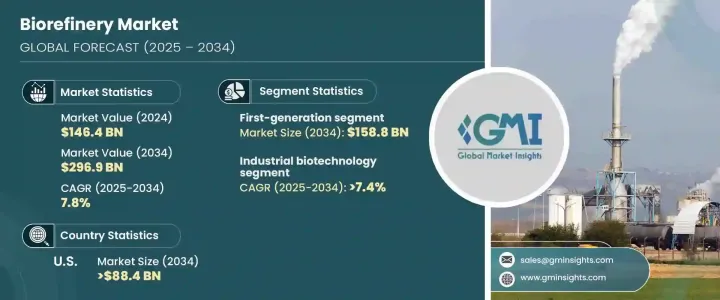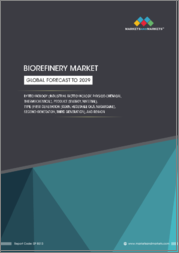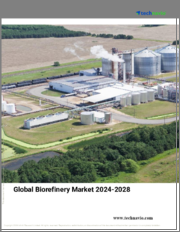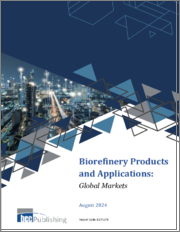
|
시장보고서
상품코드
1685181
바이오정제소 시장 : 기회, 성장 촉진요인, 산업 동향 분석(2025-2034년)Biorefinery Market Opportunity, Growth Drivers, Industry Trend Analysis, and Forecast 2025 - 2034 |
||||||
세계의 바이오정제소 시장은 2024년 1,464억 달러로 평가되었으며, 지속가능한 에너지 솔루션과 자원 효율 향상에 대한 수요 증가를 배경으로 2025년부터 2034년까지 연평균 성장률(CAGR) 7.8%로 성장할 것으로 예측됩니다.
기후 변화에 대한 우려가 높아지고, 화석연료의 매장량이 고갈됨에 따라, 재생가능에너지원으로의 대폭적인 전환이 진행되고 있으며, 바이오정제소는 이 전환에 있어 매우 중요한 역할을 하고 있습니다.

이러한 시설은 첨단 바이오매스 전환 공정을 사용하여 농업 잔재물, 임업 자재, 유기 폐기물 등의 생물 자원에서 재생 연료, 전력, 부가가치 화학 물질을 생산합니다. 또한, 친환경 대안에 대한 소비자의 인식이 높아지면서 보조금, 세제 혜택, 온실가스 배출 억제를 위한 규제 등 정부의 강력한 지원이 시장 성장을 촉진하고 있습니다. 에너지, 화학, 재료 등의 분야에서 바이오정제소의 범위가 확대되면서 혁신을 촉진하고 투자를 장려하며 보다 지속 가능한 미래에 기여하고 있습니다.
| 시장 범위 | |
|---|---|
| 시작 연도 | 2024년 |
| 예측 연도 | 2025-2034년 |
| 시작 금액 | 1,464억 달러 |
| 예측 금액 | 2,969억 달러 |
| CAGR | 7.8% |
1세대 바이오정제소 분야는 확립된 인프라와 합리적인 가격으로 2034년까지 1,588억 달러를 창출할 것으로 예상됩니다. 이 부문은 주로 사탕수수, 식물성 기름, 옥수수와 같은 식품 기반 공급 원료에 의존하며, 이는 많은 지역에서 풍부하고 널리 구할 수 있습니다. 이러한 공급 원료는 운송 및 에너지 산업에서 점점 더 많이 활용되고 있는 에탄올과 바이오 디젤과 같은 바이오 연료를 생산하는 데 매우 중요합니다. 다양한 지역의 정부 의무와 혼합 요건은 이러한 바이오 연료에 대한 수요를 더욱 강화하여 꾸준한 성장을 보장합니다. 1세대 공급 원료의 경제성과 접근성 덕분에 이해관계자들이 선호하며 지배적인 시장 지위를 확보하고 있습니다.
산업 생명공학 부문은 미생물 및 효소 공정을 사용하여 바이오매스를 고부가가치 바이오 기반 제품으로 효율적으로 전환하는 능력으로 인해 2034년까지 7.4%의 연평균 성장률을 보일 것으로 예상됩니다. 이 기술을 통해 기존 방식에 비해 환경 발자국을 줄이면서 바이오 연료, 바이오 플라스틱, 바이오 화학 물질을 생산할 수 있습니다. 합성생물학 및 대사공학의 발전으로 미생물 균주의 생산성이 향상되고 생산 비용이 절감되며 바이오 기반 제품이 다양화되고 있습니다. 산업 생명공학은 산업 전반에 걸쳐 혁신적이고 지속 가능한 솔루션을 창출하는 초석으로 부상하여 채택을 촉진하고 시장 성장을 촉진하고 있습니다.
미국의 바이오정제소 시장은 시장은 강력한 정책, 풍부한 공급 원료, 지속적인 기술 발전에 힘입어 2034년까지 884억 달러에 달할 것으로 예상됩니다. 재생 연료 표준(RFS) 및 바이오 기반 제품에 대한 세금 인센티브와 같은 노력은 바이오정제소 인프라에 대한 투자를 크게 늘렸습니다. 미국은 농업 잔재물과 임산물을 포함한 광범위한 공급원료의 혜택을 누리고 있어 1세대 및 고급 바이오정제소에 대한 꾸준한 투입이 보장됩니다. 이러한 유리한 환경과 지속적인 혁신이 결합되어 미국은 바이오 정제 시장에서 글로벌 리더로 자리매김하고 있습니다.
목차
제1장 조사 방법과 조사 범위
- 시장의 정의
- 기본 추정과 계산
- 예측 계산
- 데이터 소스
제2장 주요 요약
제3장 업계 인사이트
- 생태계 분석
- 규제 상황
- 업계에 미치는 영향요인
- 성장 촉진요인
- 업계의 잠재적 위험 및 과제
- 성장 가능성 분석
- Porter's Five Forces 분석
- PESTEL 분석
제4장 경쟁 구도
- 전략 대시보드
- 혁신과 지속가능성의 전망
제5장 시장 규모와 예측 : 유형별(2021-2034년)
- 주요 동향
- 1세대
- 2세대
- 3세대
제6장 시장 규모와 예측 : 기술별(2021-2034년)
- 주요 동향
- 산업 생명공학
- 물리 화학
- 열 화학
제7장 시장 규모와 예측 : 제품별(2021-2034년)
- 주요 동향
- 에너지 유래
- 재료 유래
제8장 시장 규모와 예측 : 지역별(2021-2034년)
- 주요 동향
- 북미
- 미국
- 캐나다
- 멕시코
- 유럽
- 영국
- 프랑스
- 독일
- 이탈리아
- 러시아
- 스페인
- 아시아태평양
- 중국
- 호주
- 인도
- 일본
- 한국
- 중동 및 아프리카
- 사우디아라비아
- 아랍에미리트(UAE)
- 터키
- 남아프리카
- 이집트
- 라틴아메리카
- 브라질
- 아르헨티나
제9장 기업 프로파일
- Borregaard
- CARGILL
- Clariant
- Godavari Biorefineries
- Green Plains
- Neste Oyj
- Renewable Energy Group
- SEKAB
- Total Energies
- Valero
- Versalis
- Vivergo Fuels
- Wilmar International Anixter
The Global Biorefinery Market was valued at USD 146.4 billion in 2024 and is projected to grow at a CAGR of 7.8% between 2025 and 2034, driven by increasing demand for sustainable energy solutions and enhanced resource efficiency. As climate change concerns escalate and fossil fuel reserves deplete, a significant transition to renewable energy sources is underway, with biorefineries playing a pivotal role in this transformation.

These facilities employ advanced biomass conversion processes to produce renewable fuels, power, and value-added chemicals from biological resources such as agricultural residues, forestry materials, and organic waste. Furthermore, growing consumer awareness of eco-friendly alternatives, along with strong governmental support through subsidies, tax incentives, and regulations aimed at curbing greenhouse gas emissions, is propelling market growth. The expanding scope of biorefineries in sectors like energy, chemicals, and materials is fostering innovation, encouraging investments, and contributing to a more sustainable future.
| Market Scope | |
|---|---|
| Start Year | 2024 |
| Forecast Year | 2025-2034 |
| Start Value | $146.4 Billion |
| Forecast Value | $296.9 Billion |
| CAGR | 7.8% |
The first-generation biorefinery segment is anticipated to generate USD 158.8 billion by 2034, driven by its well-established infrastructure and affordability. This segment relies primarily on food-based feedstocks such as sugarcane, vegetable oils, and corn, which are plenty and widely available in many regions. These feedstocks are critical in producing biofuels like ethanol and biodiesel, which are increasingly utilized in the transportation and energy industries. Government mandates and blending requirements across various regions further bolster demand for these biofuels, ensuring steady growth. The affordability and accessibility of first-generation feedstocks make them a preferred choice for stakeholders, securing their dominant market position.
The industrial biotechnology segment is forecasted to grow at a CAGR of 7.4% through 2034, owing to its ability to efficiently transform biomass into high-value bio-based products using microbial and enzymatic processes. This technology enables the production of biofuels, bioplastics, and biochemicals with a reduced environmental footprint compared to conventional methods. Advances in synthetic biology and metabolic engineering are enhancing microbial strains' productivity, reducing production costs, and diversifying bio-based product offerings. Industrial biotechnology has emerged as a cornerstone for creating innovative, sustainable solutions across industries, driving its adoption and fueling market growth.
The U.S. biorefinery market is projected to reach USD 88.4 billion by 2034, supported by robust policies, abundant feedstock availability, and continuous technological advancements. Initiatives such as the Renewable Fuel Standard (RFS) and tax incentives for bio-based products have significantly boosted investment in biorefinery infrastructure. The U.S. benefits from an extensive supply of feedstocks, including agricultural residues and forest materials, ensuring a steady input for first-generation and advanced biorefineries. This favorable environment, coupled with ongoing innovation, positions the U.S. as a global leader in the biorefinery market.
Table of Contents
Chapter 1 Methodology & Scope
- 1.1 Market definitions
- 1.2 Base estimates & calculations
- 1.3 Forecast calculation
- 1.4 Data sources
- 1.4.1 Primary
- 1.4.2 Secondary
- 1.4.2.1 Paid
- 1.4.2.2 Public
Chapter 2 Executive Summary
- 2.1 Industry synopsis, 2021 - 2034
Chapter 3 Industry Insights
- 3.1 Industry ecosystem analysis
- 3.2 Regulatory landscape
- 3.3 Industry impact forces
- 3.3.1 Growth drivers
- 3.3.2 Industry pitfalls & challenges
- 3.4 Growth potential analysis
- 3.5 Porter's analysis
- 3.5.1 Bargaining power of suppliers
- 3.5.2 Bargaining power of buyers
- 3.5.3 Threat of new entrants
- 3.5.4 Threat of substitutes
- 3.6 PESTEL analysis
Chapter 4 Competitive landscape, 2024
- 4.1 Strategic dashboard
- 4.2 Innovation & sustainability landscape
Chapter 5 Market Size and Forecast, By Type, 2021 – 2034 (USD Million)
- 5.1 Key trends
- 5.2 First generation
- 5.3 Second generation
- 5.4 Third generation
Chapter 6 Market Size and Forecast, By Technology, 2021 – 2034 (USD Million)
- 6.1 Key trends
- 6.2 Industrial biotechnology
- 6.3 Physio chemical
- 6.4 Thermochemical
Chapter 7 Market Size and Forecast, By Product, 2021 – 2034 (USD Million)
- 7.1 Key trends
- 7.2 Energy driven
- 7.3 Material driven
Chapter 8 Market Size and Forecast, By Region, 2021 – 2034 (USD Million)
- 8.1 Key trends
- 8.2 North America
- 8.2.1 U.S.
- 8.2.2 Canada
- 8.2.3 Mexico
- 8.3 Europe
- 8.3.1 UK
- 8.3.2 France
- 8.3.3 Germany
- 8.3.4 Italy
- 8.3.5 Russia
- 8.3.6 Spain
- 8.4 Asia Pacific
- 8.4.1 China
- 8.4.2 Australia
- 8.4.3 India
- 8.4.4 Japan
- 8.4.5 South Korea
- 8.5 Middle East & Africa
- 8.5.1 Saudi Arabia
- 8.5.2 UAE
- 8.5.3 Turkey
- 8.5.4 South Africa
- 8.5.5 Egypt
- 8.6 Latin America
- 8.6.1 Brazil
- 8.6.2 Argentina
Chapter 9 Company Profiles
- 9.1 Borregaard
- 9.2 CARGILL
- 9.3 Clariant
- 9.4 Godavari Biorefineries
- 9.5 Green Plains
- 9.6 Neste Oyj
- 9.7 Renewable Energy Group
- 9.8 SEKAB
- 9.9 Total Energies
- 9.10 Valero
- 9.11 Versalis
- 9.12 Vivergo Fuels
- 9.13 Wilmar International Anixter



















